Jiazhi Guan
AudCast: Audio-Driven Human Video Generation by Cascaded Diffusion Transformers
Mar 25, 2025Abstract:Despite the recent progress of audio-driven video generation, existing methods mostly focus on driving facial movements, leading to non-coherent head and body dynamics. Moving forward, it is desirable yet challenging to generate holistic human videos with both accurate lip-sync and delicate co-speech gestures w.r.t. given audio. In this work, we propose AudCast, a generalized audio-driven human video generation framework adopting a cascade Diffusion-Transformers (DiTs) paradigm, which synthesizes holistic human videos based on a reference image and a given audio. 1) Firstly, an audio-conditioned Holistic Human DiT architecture is proposed to directly drive the movements of any human body with vivid gesture dynamics. 2) Then to enhance hand and face details that are well-knownly difficult to handle, a Regional Refinement DiT leverages regional 3D fitting as the bridge to reform the signals, producing the final results. Extensive experiments demonstrate that our framework generates high-fidelity audio-driven holistic human videos with temporal coherence and fine facial and hand details. Resources can be found at https://guanjz20.github.io/projects/AudCast.
Cosh-DiT: Co-Speech Gesture Video Synthesis via Hybrid Audio-Visual Diffusion Transformers
Mar 13, 2025Abstract:Co-speech gesture video synthesis is a challenging task that requires both probabilistic modeling of human gestures and the synthesis of realistic images that align with the rhythmic nuances of speech. To address these challenges, we propose Cosh-DiT, a Co-speech gesture video system with hybrid Diffusion Transformers that perform audio-to-motion and motion-to-video synthesis using discrete and continuous diffusion modeling, respectively. First, we introduce an audio Diffusion Transformer (Cosh-DiT-A) to synthesize expressive gesture dynamics synchronized with speech rhythms. To capture upper body, facial, and hand movement priors, we employ vector-quantized variational autoencoders (VQ-VAEs) to jointly learn their dependencies within a discrete latent space. Then, for realistic video synthesis conditioned on the generated speech-driven motion, we design a visual Diffusion Transformer (Cosh-DiT-V) that effectively integrates spatial and temporal contexts. Extensive experiments demonstrate that our framework consistently generates lifelike videos with expressive facial expressions and natural, smooth gestures that align seamlessly with speech.
TALK-Act: Enhance Textural-Awareness for 2D Speaking Avatar Reenactment with Diffusion Model
Oct 14, 2024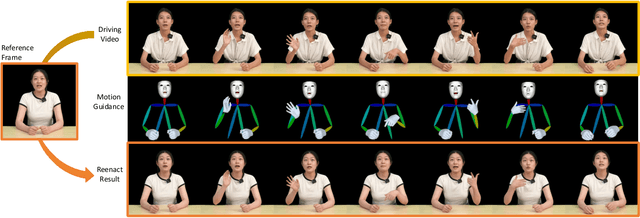

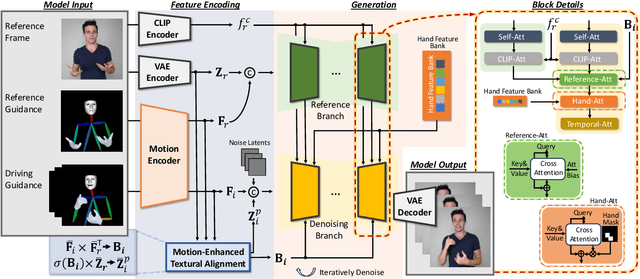

Abstract:Recently, 2D speaking avatars have increasingly participated in everyday scenarios due to the fast development of facial animation techniques. However, most existing works neglect the explicit control of human bodies. In this paper, we propose to drive not only the faces but also the torso and gesture movements of a speaking figure. Inspired by recent advances in diffusion models, we propose the Motion-Enhanced Textural-Aware ModeLing for SpeaKing Avatar Reenactment (TALK-Act) framework, which enables high-fidelity avatar reenactment from only short footage of monocular video. Our key idea is to enhance the textural awareness with explicit motion guidance in diffusion modeling. Specifically, we carefully construct 2D and 3D structural information as intermediate guidance. While recent diffusion models adopt a side network for control information injection, they fail to synthesize temporally stable results even with person-specific fine-tuning. We propose a Motion-Enhanced Textural Alignment module to enhance the bond between driving and target signals. Moreover, we build a Memory-based Hand-Recovering module to help with the difficulties in hand-shape preserving. After pre-training, our model can achieve high-fidelity 2D avatar reenactment with only 30 seconds of person-specific data. Extensive experiments demonstrate the effectiveness and superiority of our proposed framework. Resources can be found at https://guanjz20.github.io/projects/TALK-Act.
ReSyncer: Rewiring Style-based Generator for Unified Audio-Visually Synced Facial Performer
Aug 06, 2024



Abstract:Lip-syncing videos with given audio is the foundation for various applications including the creation of virtual presenters or performers. While recent studies explore high-fidelity lip-sync with different techniques, their task-orientated models either require long-term videos for clip-specific training or retain visible artifacts. In this paper, we propose a unified and effective framework ReSyncer, that synchronizes generalized audio-visual facial information. The key design is revisiting and rewiring the Style-based generator to efficiently adopt 3D facial dynamics predicted by a principled style-injected Transformer. By simply re-configuring the information insertion mechanisms within the noise and style space, our framework fuses motion and appearance with unified training. Extensive experiments demonstrate that ReSyncer not only produces high-fidelity lip-synced videos according to audio, but also supports multiple appealing properties that are suitable for creating virtual presenters and performers, including fast personalized fine-tuning, video-driven lip-syncing, the transfer of speaking styles, and even face swapping. Resources can be found at https://guanjz20.github.io/projects/ReSyncer.
Building an Invisible Shield for Your Portrait against Deepfakes
May 22, 2023Abstract:The issue of detecting deepfakes has garnered significant attention in the research community, with the goal of identifying facial manipulations for abuse prevention. Although recent studies have focused on developing generalized models that can detect various types of deepfakes, their performance is not always be reliable and stable, which poses limitations in real-world applications. Instead of learning a forgery detector, in this paper, we propose a novel framework - Integrity Encryptor, aiming to protect portraits in a proactive strategy. Our methodology involves covertly encoding messages that are closely associated with key facial attributes into authentic images prior to their public release. Unlike authentic images, where the hidden messages can be extracted with precision, manipulating the facial attributes through deepfake techniques can disrupt the decoding process. Consequently, the modified facial attributes serve as a mean of detecting manipulated images through a comparison of the decoded messages. Our encryption approach is characterized by its brevity and efficiency, and the resulting method exhibits a good robustness against typical image processing traces, such as image degradation and noise. When compared to baselines that struggle to detect deepfakes in a black-box setting, our method utilizing conditional encryption showcases superior performance when presented with a range of different types of forgeries. In experiments conducted on our protected data, our approach outperforms existing state-of-the-art methods by a significant margin.
StyleSync: High-Fidelity Generalized and Personalized Lip Sync in Style-based Generator
May 09, 2023Abstract:Despite recent advances in syncing lip movements with any audio waves, current methods still struggle to balance generation quality and the model's generalization ability. Previous studies either require long-term data for training or produce a similar movement pattern on all subjects with low quality. In this paper, we propose StyleSync, an effective framework that enables high-fidelity lip synchronization. We identify that a style-based generator would sufficiently enable such a charming property on both one-shot and few-shot scenarios. Specifically, we design a mask-guided spatial information encoding module that preserves the details of the given face. The mouth shapes are accurately modified by audio through modulated convolutions. Moreover, our design also enables personalized lip-sync by introducing style space and generator refinement on only limited frames. Thus the identity and talking style of a target person could be accurately preserved. Extensive experiments demonstrate the effectiveness of our method in producing high-fidelity results on a variety of scenes. Resources can be found at https://hangz-nju-cuhk.github.io/projects/StyleSync.
Detecting Deepfake by Creating Spatio-Temporal Regularity Disruption
Jul 21, 2022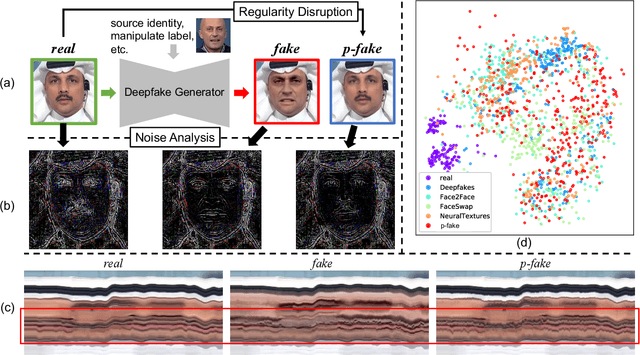
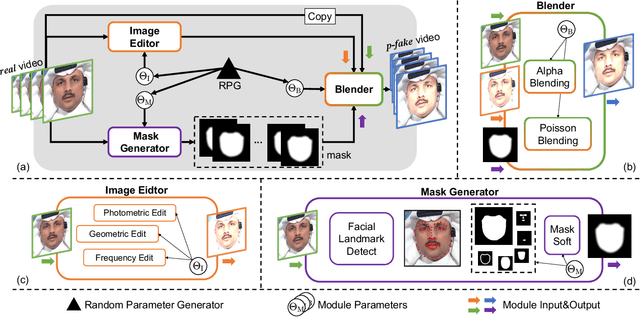
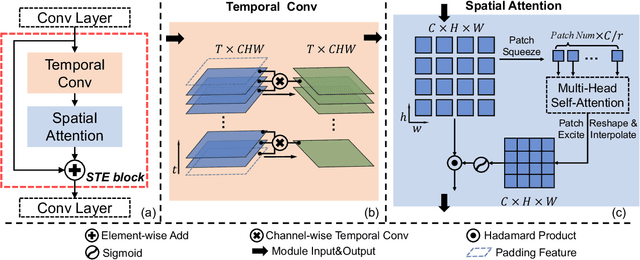
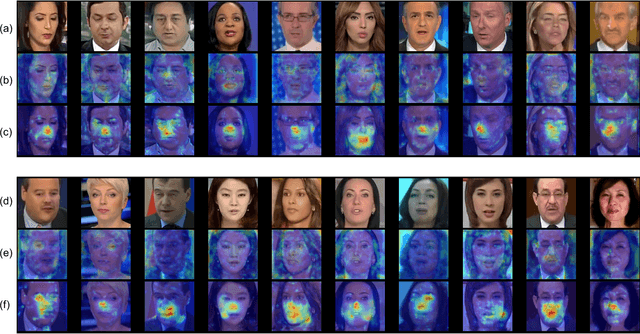
Abstract:Despite encouraging progress in deepfake detection, generalization to unseen forgery types remains a significant challenge due to the limited forgery clues explored during training. In contrast, we notice a common phenomenon in deepfake: fake video creation inevitably disrupts the statistical regularity in original videos. Inspired by this observation, we propose to boost the generalization of deepfake detection by distinguishing the "regularity disruption" that does not appear in real videos. Specifically, by carefully examining the spatial and temporal properties, we propose to disrupt a real video through a Pseudo-fake Generator and create a wide range of pseudo-fake videos for training. Such practice allows us to achieve deepfake detection without using fake videos and improves the generalization ability in a simple and efficient manner. To jointly capture the spatial and temporal disruptions, we propose a Spatio-Temporal Enhancement block to learn the regularity disruption across space and time on our self-created videos. Through comprehensive experiments, our method exhibits excellent performance on several datasets.
Delving into Sequential Patches for Deepfake Detection
Jul 06, 2022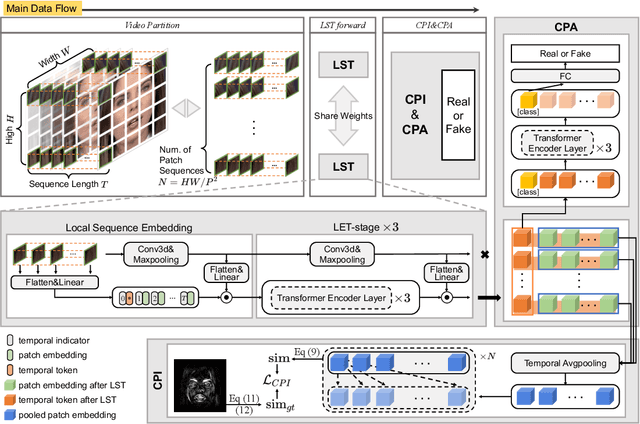
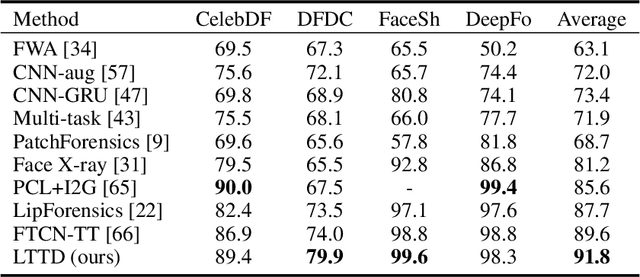
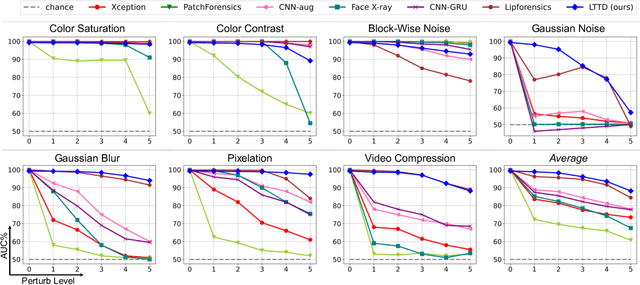

Abstract:Recent advances in face forgery techniques produce nearly visually untraceable deepfake videos, which could be leveraged with malicious intentions. As a result, researchers have been devoted to deepfake detection. Previous studies has identified the importance of local low-level cues and temporal information in pursuit to generalize well across deepfake methods, however, they still suffer from robustness problem against post-processings. In this work, we propose the Local- & Temporal-aware Transformer-based Deepfake Detection (LTTD) framework, which adopts a local-to-global learning protocol with a particular focus on the valuable temporal information within local sequences. Specifically, we propose a Local Sequence Transformer (LST), which models the temporal consistency on sequences of restricted spatial regions, where low-level information is hierarchically enhanced with shallow layers of learned 3D filters. Based on the local temporal embeddings, we then achieve the final classification in a global contrastive way. Extensive experiments on popular datasets validate that our approach effectively spots local forgery cues and achieves state-of-the-art performance.
 Add to Chrome
Add to Chrome Add to Firefox
Add to Firefox Add to Edge
Add to Edge